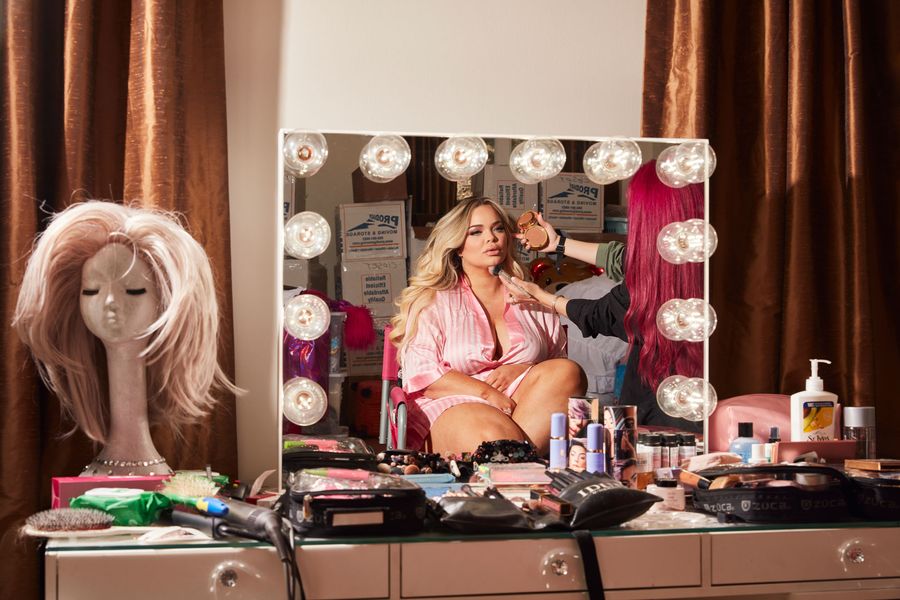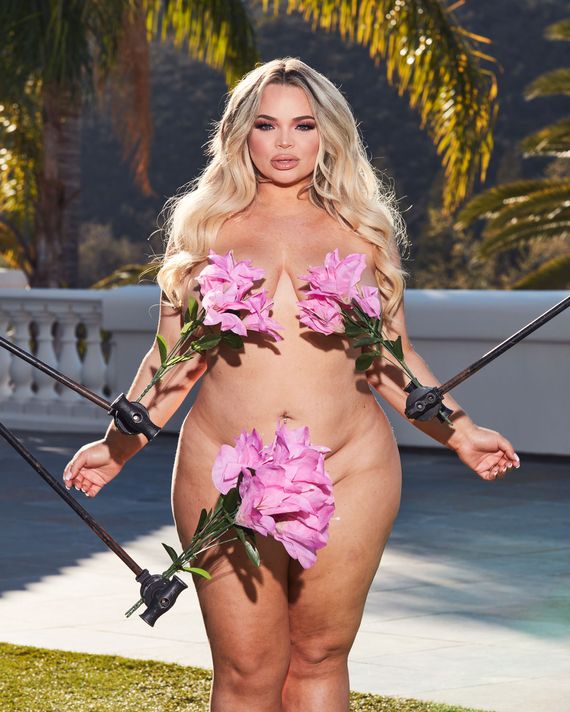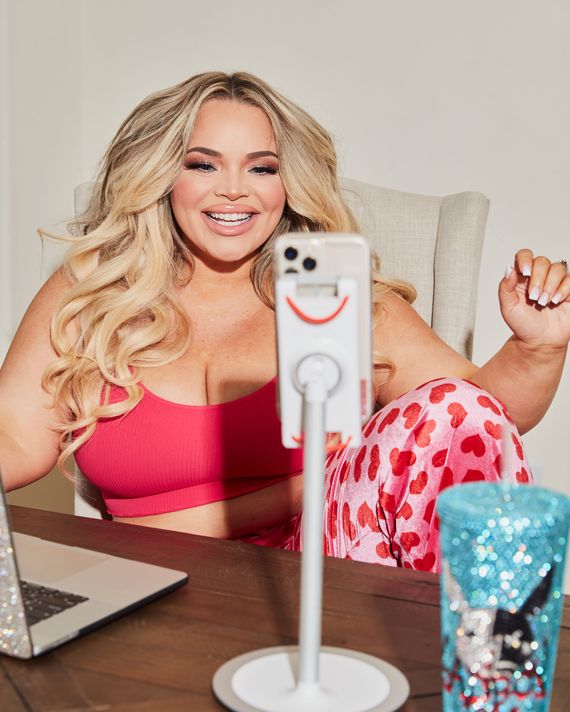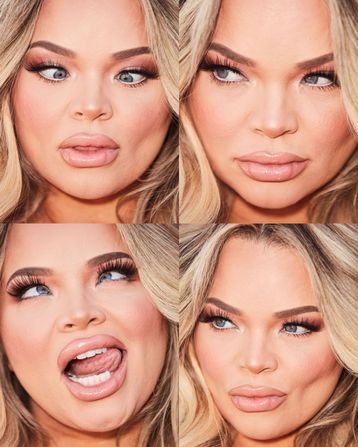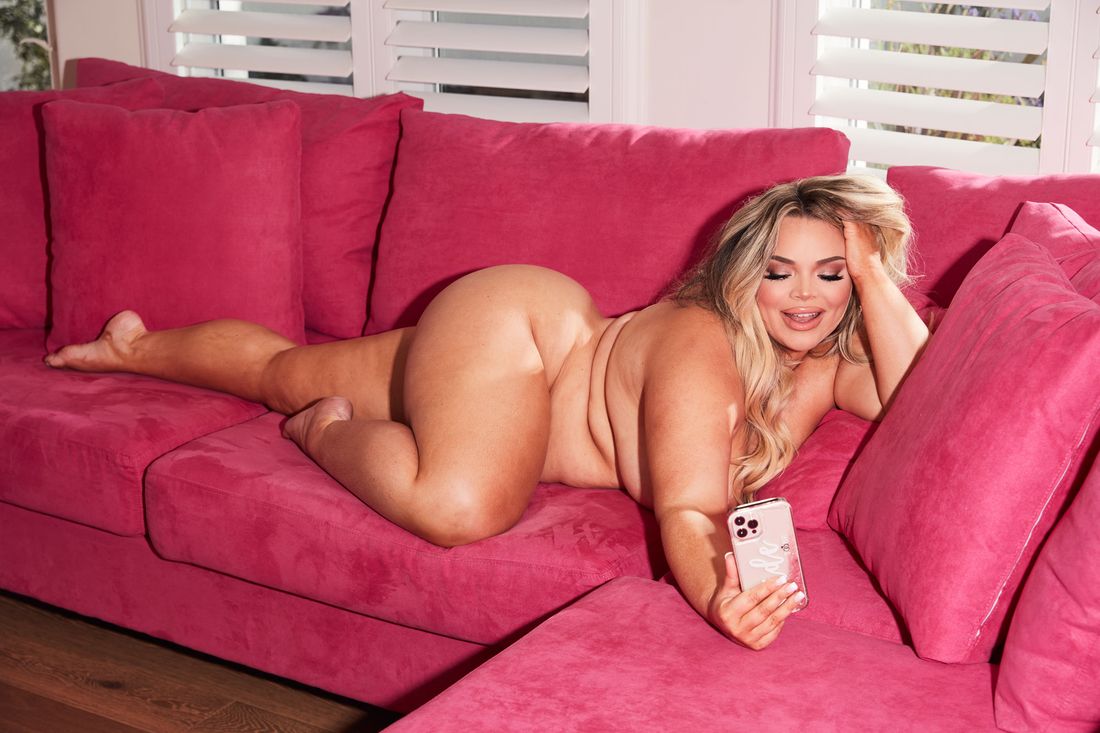
Within seconds, Trisha Paytas has already managed to shock me. She’s in full L.A.-influencer drag: platinum-blonde extensions, baby-pink acrylics, cut-crease smoky eye, and a stiff, plump beige pout. Seated in the kitchen of her still mostly empty five-bedroom, eight-bathroom new home in Ventura County — where everything is white and tan and has that California casual-chic look that’s become standard issue for the YouTube famous — she looks so … normal. And then she opens her mouth.
Paytas is recounting her current obsession with Adam Sandler, and not in a “I’m rewatching 50 First Dates” way. More in the genre of “I just spent thousands of dollars on at least a dozen of his actual movie costumes.” “He’s Jewish and funny and schlubby and gets really attractive people in all his movies,” she explains. “So right now my phase is, ‘I want to be him.’ I’m sure in six months I’m going to be someone else.”
She is not kidding. This is, in fact, the essence of Trisha Paytas, who has spent the last decade and a half trying on different identities to see which ones will make her the most famous. Some have worked: In 2010 she attempted to beat the Guinness World Record for speed-talking, and despite failing to do so still scored appearances on The Ellen DeGeneres Show and America’s Got Talent. Throughout her career she estimates she’s been on 30 reality-TV shows. She has written 11 “self-help” books and recorded ten albums (mostly dance pop, but she did recently come out with a mid-aughts emo-inspired EP under the name Sadboy2005), none of which made the charts. Yet nothing has been more successful in getting Paytas attention than what she does best: pissing people off. She is among the handful of YouTubers, most of whom either hate each other or at least pretend to, who have necessitated the formation of an entire drama-channel cottage industry devoted to explaining their constantly fluctuating relationships. Of her divisive peers — Shane Dawson, Jeffree Star, James Charles, Tana Mongeau, Nikita Dragun, the Paul Brothers — Paytas, the enigmatic big-boobed bimbo in the most self-aware sense of the word, is by far the most compelling, having perfected a mode of influencer-hood that inverts what the profession is.
If a typical influencer presents a consistent, idealized version of what 2010s internet culture has taught us to desire, Paytas gives us the opposite: a chaotic and (mostly) unglamorous portrait of whatever or whomever she’s feeling that day. One of her favorite methods of addressing her fans is by talking directly to the camera while eating, say, the new Pizza Hut Triple Treat Box or chicken fries in her car. (It’s a whole YouTube art form known as a mukbang, and she’s a pro at it.) Recent stylistic phases have included emo bandleader, kawaii à la Care Bear, and Domino’s Pizza employee (though she has since moved on to Papa John’s). The result is camp in its purest form, crafted by someone who’s in on the joke but takes it perfectly seriously. “Whenever I dress up, I put a lot of time and money and effort into it,” she says. “Some people think I’m ironic, but I don’t know how to do that. I don’t think I get it fully.”
For the best sense of how famous Paytas is, simply go find the nearest teenager and ask them. But if we’re talking actual numbers: She has a follower count of 6 million on her two YouTube channels, 4.9 million on TikTok, three-quarters of a million on Twitter, and more than 300,000 on Instagram, but only because her original account was banned “for repeatedly breaking our rules,” according to a Facebook spokesperson — mostly for nudity and sexual content. The fun of being Paytas’s follower is in everything from discovering what she’s wearing that morning to who she’s mad at this week or, frequently, the latest problematic thing she’s said. And then, watching drama and commentary channels explain it all in videos titled everything WRONG with trisha paytas and Trisha Paytas being toxic and abusive for 10 minutes straight. In the past year, Paytas has publicly feuded with Charli D’Amelio, the world’s most famous 16-year-old TikToker, broken up her decade-long friendship with the only people in the YouTubersphere whose résumés of scandal are as long as her own (Dawson and Star), and outraged more than one marginalized community. It is impossible to separate Paytas’s endless pursuit of attention from the things she has done to get it: She has been filmed rapping the N-word multiple times. She’s been accused of making mockeries of gender identities and mental disorders. Her videos have, on many occasions, flagrantly crossed the line between satire and cruelty.
As with many professionally charismatic people who have done bad things, those serious lapses of judgment are easy to forget when talking to the woman directly. Paytas, 32, is infectiously bubbly and at times insecure to the point of making you feel a little bit sorry for her; whether that’s her goal is a question that never really leaves your mind. She is remarkably forthcoming; it can feel like she’s confiding her secrets in you even though everyone already knows them. She talks about how she’s grown from her “trolling” days within the notoriously toxic 2010s YouTube culture. She tells me about her plastic surgeries and liposuctions. She speaks soberly about the three times she was on an involuntary psychiatric hold. She tells me she wants to be remembered as a good person.
Paytas has become immune to cancellation in a way that only a handful of people can do successfully: Trump is one — and the rest are pretty much all on YouTube.
Paytas “blacked out” much of her life growing up, which was spent mostly outside Rockford, Illinois, with her mother, and occasionally, in Riverside, California with her father. “All I remember is I was kind of a loner, and that people weren’t necessarily mean to me but I didn’t have any friends,” she says. When her mother wasn’t working one of many overlapping jobs –– as a teaching aide, bus driver, bartender, and postal worker –– she was more friend than parent. “I said I wanted to be a stripper at 12 and she was like, ‘Okay.’”
In her late teens, Paytas started living with and dating an older man who was formerly Alice Cooper’s personal assistant. When he began demanding rent money, she got a job at his friends’ strip club, Godfather, in the Van Nuys neighborhood of Los Angeles, despite the fact that she didn’t know how to dance. She met a woman there who encouraged her to start escorting. At first, she had fun — she’d sleep with famous people (or at least people who knew famous people) and wealthy businessmen from out of town. She tells a story about a celebrity-adjacent client who used to get off by pretending he was Elvis and shooting rounds over her head (“I stopped seeing him because I thought, Oh, maybe he wants to kill me”). Then, well, drugs happened — coke, heroin, whatever was around. “They [didn’t] want a girl that was already strung out coming to their house,” she says. “So I would end up on Santa Monica Boulevard and hook there for literally five dollars or just a place to stay.”
Soon, a platform would arrive where the money was just as good and you didn’t even have to leave your house. Paytas posted her first YouTube video (a 43-second clip of herself rapping “Ice Ice Baby”) in 2007 under the channel “blndsundoll4mj,” named for the hair color she’d always wanted, “sun doll” after her love of tanning, and “4mj” because of an obsession with Michael Jackson. The first few dozen videos were largely devoted to her love of a different famous person, Quentin Tarantino, which included impressions of the director, reenactments of his films, and at least one video in which she simulates a graphic makeout session between herself and a pillow taped with a photo of his face — until, of course, she moved onto other fixations.
She wouldn’t truly hit the YouTube jackpot until 2012, when she posted a video called “Why I’m Voting for Mitt Romney,” citing reasons such as “he’s super gorgeous and hot” and “my kitten is named Mitts.” In it, she also claimed she didn’t like Obama because “he’s gonna take away my right to be a Catholic” (he was not). It was her first taste of professional trollhood, and it worked: The video got 3 million views. Thanks to YouTube’s then-lucrative AdSense program, through which top creators were earning upward of six figures, it also netted her $8,000. It was more money than she’d made that whole year. “I thought, like, I’m not really talented or anything, so maybe I just need to try and offend as many people as possible to get money.”
So she started collecting controversies: There was the phase in 2011, and again in 2012, when she dressed up as “Trishii,” a character she invented that was supposed to be a Japanese pop star but mostly ended up just being racist; there was the one video in 2013 when she wondered aloud whether dogs have brains. There was the time in October 2019 where she uploaded a video titled “I AM TRANSGENDER (FEMALE TO MALE)” in which she claimed to identify as a gay man. Considering she’d previously claimed to identify as a chicken nugget, the video was met with outrage and mistrust. She stands by it, at least in theory. Her reasoning is she now identifies as nonbinary, but didn’t have the vocabulary to describe it at the time (her pronouns are both she/her and they/them). Of her use of the N-word on camera, Paytas gives the response that’s now standard issue for influencers: “Obviously it was gross and awful and that’s so embarrassing that I have that clip out there about that, because I’m like, so not that person.”
She managed to incense another community when, in March of 2020, she claimed to have dissociative identity disorder, the highly stigmatized diagnosis formerly known as multiple personality disorder. YouTubers who’d built their channels by being open about their struggles with DID accused her of spreading misinformation and self-diagnosing rather than seeking help. Again, she insists, it wasn’t trolling. “I was like, This is so fucking crazy that people are doubting me.” So she made a video in which she pretended to switch personalities on camera.
Okay, that one was trolling.
All that aside, Paytas’s mental health is not a joke. She was diagnosed with borderline personality disorder at age 31, and previously received two paranoid schizophrenia diagnoses at age 12 and again at 18. Her mood shifts when we land on the topic of the three times she was involuntarily committed to a mental facility in 2019. At the time, Paytas was part of a group of YouTubers called the Vlog Squad, best known for performing stunts and pulling pranks of varying degrees of ethicality on each other in enormous Los Angeles mansions. It was led by David Dobrik, who, until recently, was one of the few YouTubers who enjoyed a relatively unsoiled reputation by industry standards. But over the past few weeks, multiple former members have accused him of fostering a toxic work/creative environment; one alleged that a supposed “prank” was sexual assault.
Paytas started dating Vlog Squad member Jason Nash in 2017 and their two-year relationship was a common one for the world of YouTube, where terms like “boyfriend” and “girlfriend” have completely different meanings on camera and off — a video could be titled something like, “GIRLFRIEND PICKS MY OUTFIT,” yet both parties understand this is mostly a label of convenient storytelling than any sort of commitment. Whatever type of relationship they had ended when Trisha was no longer useful for the Vlog Squad, she says. “Jason was like, ‘I gotta break up with you because of David.’ That’s when I spiraled.”
In February of 2019, while she was getting ready for a party, Jason sent her a breakup text. She’d already been drinking, and upon receiving it, she took a Xanax and a Vicodin. She woke up in Cedars-Sinai. “Jason and David come while I’m lying on the stretcher, and I’m like, ‘Get the fuck out.’ I get off the gurney, I take off my gown, I start running out of the hospital and security people drag me and shoot Ativan in my thigh and strap me down.” (Dobrik and Nash did not respond to multiple requests for comment.) “I have more PTSD from David and Jason than I do hooking on Santa Monica Boulevard,” she says.
Paytas was admitted for a second time a few months later, during a period where she says she was addicted to painkillers. “May [2019] was a brutal month for me,” she says. “A lot of hate videos were being made.” She doesn’t remember what happened, but according to the police filing, when they came by for a wellness check there were “pills and piss everywhere.” The third time, later that year, happened when she was on Instagram Live while high — she suspects it was a viewer who called the authorities.
Paytas does seem to be doing well now. She’s in therapy and says she’s mostly handling her BPD, though she’s recently started to worry about the voices she occasionally hears in her head. She’s engaged to a man from Israel named Moses (hence the current obsession with Judaism and Adam Sandler); they’re planning three separate weddings (one in L.A., one in Israel, and another in Maui) for the end of this year. She has a new house to decorate and a popular podcast she co-hosts with YouTuber Ethan Klein. It’s also the wealthiest she’s ever been. Along with most YouTubers, her ad revenue drastically declined from its peak in the mid-2010s — at one point she says she was making $200,000 per year off of YouTube ads alone — and she now estimates that about 70 percent of her income comes from her OnlyFans, the platform used most famously by sex workers, where creators can paywall their content, which costs $4.99 a month. Her subscriber count there fluctuates, but at around 22,000 to 32,000 per month, she’s in the top .01 percent of creators. (OnlyFans does not comment on the metrics of individual creators). Even minus the 20 percent commission OnlyFans charges, she’s still making $1 million a year. “Everyone assumed I’d always done porn, but I never thought I would,” says Paytas, who joined last year. “But I think at 32 I was kinda like, ‘Who really cares? My image is already tarnished.’” She tells me this is also the first time in her life where she’s actually proud of the content she puts online, now that she’s happier, more stable, and, crucially, no longer considers herself a troll.
Is it possible to take Trisha at her word — that she’s changed and she’s trying and that she’s sorry? For someone who has documented an abnormally large portion of her life for more than a decade, it would be unreasonable to demand perfect consistency of thought. But Paytas wouldn’t be herself if she weren’t altering who “herself” is nearly constantly. The cynical part of her knows her audience and the rest of Yollywood will indulge her whims and make excuses for her more despicable behaviors and outbursts on the grounds that she lets us ride along on the roller coaster of her mind. It is the privilege of people gifted with undeniable magnetism who are also willing to expose the ugliest parts of themselves — or to use a term more closely associated with Trump, to say the quiet parts out loud. It’s the same part of her that knows people on the internet don’t actually care if you say outrageous things as long as you’re keeping them entertained.
Besides, there’s just something about Paytas that feels beyond the current moment. You start to get the sense that this is a woman who, no matter what period of history you drop her into, would find a way to get famous — or at least make enough trouble to get people talking.

